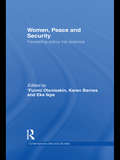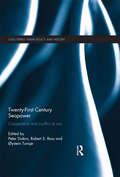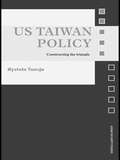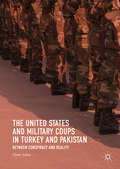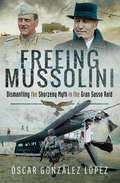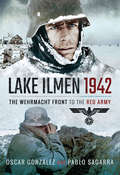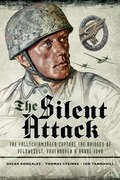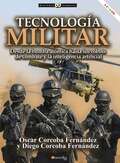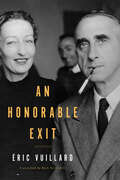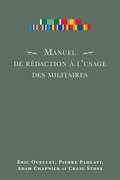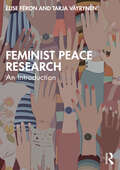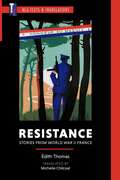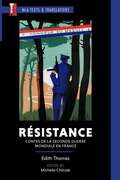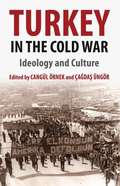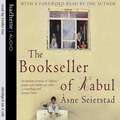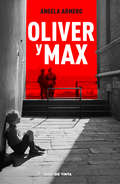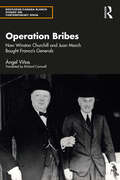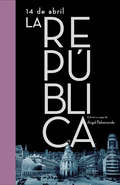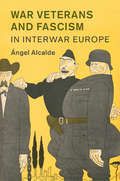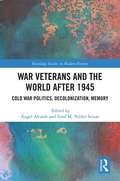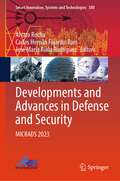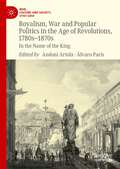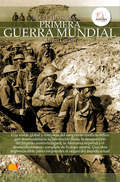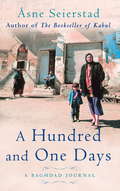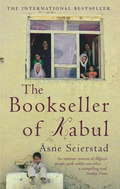- Table View
- List View
Women, Peace and Security: Translating Policy into Practice (Contemporary Security Studies)
by ’Funmi Olonisakin Karen Barnes Eka IkpeThis book provides a critical assessment of the impact of UN Resolution 1325 by examining the effect of peacebuilding missions on increasing gender equality within conflict-affected countries. UN Resolution 1325 was adopted in October 2000, and was the first time that the security concerns of women in situations of armed conflict and their role in peacebuilding was placed on the agenda of the UN Security Council. It was an important step forward in terms of bringing women’s rights and gender equality to bear in the UN’s peace and security agenda. More than a decade after the adoption of this Resolution, its practical reality is yet to be substantially felt on the ground in the very societies and regions where women remain disproportionately affected by armed conflict and grossly under-represented in peace processes. This realization, in part, led to the adoption in 2008 and 2009 of three other Security Council Resolutions, on sexual violence in conflict, violence against women, and for the development of indicators to measure progress in addressing women, peace and security issues. The book draws together the findings from eight countries and four regional contexts to provide guidance on how the impact of Resolution 1325 can be measured, and how peacekeeping operations could improve their capacity to effectively engender security. This book will be of much interest to students of peacebuilding, gender studies, the United Nations, international security and IR in general.
Twenty-First Century Seapower: Cooperation and Conflict at Sea (Cass Series: Naval Policy and History)
by Robert S. Ross Peter Dutton Øystein TunsjøThis book offers an assessment of the naval policies of emerging naval powers, and the implications for maritime security relations and the global maritime order. Since the end of the Cold War, China, Japan, India and Russia have begun to challenge the status quo with the acquisition of advanced naval capabilities. The emergence of rising naval powers is a cause for concern, as the potential for great power instability is exacerbated by the multiple maritime territorial disputes among new and established naval powers. This work explores the underlying sources of maritime ambition through an analysis of various historical cases of naval expansionism. It analyses both the sources and dynamics of international naval competition, and looks at the ways in which maritime stability and the widespread benefits of international commerce and maritime resource extraction can be sustained through the twenty-first century. This book will be of much interest to students of naval power, Asian security and politics, strategic studies, security studies and IR in general.
US Taiwan Policy: Constructing the Triangle
by Øystein TunsjøThe relationship between the United States and China is one of the most important issues in the twenty-first century, and is, ultimately, hostage to conditions across the Taiwan Strait. This book is the first to attempt to trace the historical origin of what is known as theTaiwan issue in US-China relations from a constructivist perspective.
The United States and Military Coups in Turkey and Pakistan: Between Conspiracy and Reality
by Ömer AslanThis comparative study explores the involvement of the United States in four successful military coups in Turkey and Pakistan during the Cold War. Focusing on military-to-military relations with the US in each country, the book offers insight into how external actors can impact the outcomes of coups, particularly through socialization via military training, education, and international organizations such as NATO. Drawing upon recently declassified government documents and a trove of unexplored interviews with high-ranking officials, Ömer Aslan also examines how coup plotters in both countries approached the issue of US reaction before, during, and after their coups. As armed forces have continued to make and unmake Turkish and Pakistani governments well into the twenty-first century, this volume offers original, probing analysis of the circumstances which make coups possible.
Freeing Mussolini: Dismantling the Skorzeny Myth in the Gran Sasso Raid
by Óscar González LópezThe untold inside story of the audacious Nazi plot to rescue il Duce from an Allied prison. The operation to free Mussolini, who was being held prisoner in a high mountain hotel on the summit of Gran Sasso, Italy, in September 1943, is without a doubt one of the most spectacular operations not only of the Second World War, but in all military history. German paratroopers, the Wehrmacht’s elite, were responsible for organizing the rescue in record time, and executing a daring and perfectly synchronized operation between land and airborne detachments. Surprise and speed were the Fallschirmjäger’s main weapons, surprising the Italian garrison guarding il Duce. For political reasons Otto Skorzeny, the clever SS officer, also participated in the operation, leading a dozen of his commandos. Propaganda and his connections with Himmler made him into the false hero of the mission, over-emphasizing his role in the whole search and rescue operation. Based on the testimony of several protagonists in this incredible operation, as well as analyzing major documents (letters, reports by General Kurt Student, etc.) and the abundant literature available on the subject, this book dismantles the “Skorzeny Myth” and reveals the truth of what really happened in a mission that even Churchill called “one of great daring.”
Lake Ilmen, 1942: The Wehrmacht Front to the Red Army
by Óscar González Pablo SagarraThis WWII combat history sheds light on the Battle for Staraya Russa, in which German soldiers and Spanish volunteers bitterly fought the Red Army. In January 1942, in the Staraya Russa sector south of Lake Ilmen, the 16th German Army clashed with Vasili Morozov's 11th Soviet Army for possession of the region. Fighting alongside the Germans were the Spanish volunteers of the Blue Division. Though the fighting lasted for nearly a month, the battle for Staraya Russa is all but forgotten in studies of the Second World War&’s Eastern Front. In Lake Ilmen, 1942, the authors present a strategic framework of the battle from both the German and Russian perspectives. They also recount the hard fighting and extreme weather endured by both sides, bringing the human aspect of the conflict to life through a survey of individual volunteers who fought in it.
The Silent Attack: The Fallschirmjäger Capture of the Bridges of Veldwezelt, Vroenhoven & Hanne 1940
by Thomas Steinke Ian Tannahill Óscar González&“An enthralling account of how German Special Forces fought to take and hold the key river crossings to allow the main German Army to swarm into France.&”—Firetrench Much has been written about the capture of Fort Eben-Emael in Belgium by German paratroopers, on May 10, 1940. This operation marked the first use of gliders and shaped charges—and proved it possible to drop paratroopers behind enemy lines. Training, secrecy, accuracy and speed linked to the element of surprise made these men lethal, causing chaos among Belgian soldiers. However, it should be stressed that these paratroopers were part of a larger group: The Sturmablteilung Koch (Koch Assault Group), the elite of the Luftwaffe in 1940, whose mission was not only to take Eben-Emael, but also the three bridges over the Alberto Canal near Veldwezelt, Vroenhoven, and Kanne. The success of the attack on Belgium and France would depend on the rapid conquest of those bridges. The aim of this book is to show how the assault on the Albert Canal bridges was planned and carried out, based on documents, records and evidence, and also through many photos never published until now. Every detail—from the creation of the Koch Assault Group to the final attack—has been impeccably researched, as well as verified through testimonies of Belgian and German soldiers. &“An impressive and beautifully presented book, with a meticulously researched, clear and readable narrative which is generously supported by innumerable photographs, first-hand accounts and a complete list of all those who took part. This must be considered an important addition to the library of airborne literature.&”—Pegasus Archive
Tecnología militar (Historia Incógnita)
by Óscar Corcoba FernándezTecnología militar nos adentra en un contexto en el que el desarrollo de armas, desde las más pequeñas e invisibles, hasta las más grandes y mortíferas van a tener una enorme influencia en la política internacional y el modelado del mundo durante la segunda mitad del S.XX y el S.XXI.
An Honorable Exit
by Éric VuillardFrom the award-winning author of The Order of the Day, a piercing account of the lesser-known conflict preceding the Vietnam War that dealt a fatal blow to French colonialism.How can a modern army lose to an army of peasants? Delving into the last gasps of the First Indochina War (1946–1954), which saw the communist Việt Minh take control of North Vietnam, Éric Vuillard vividly illustrates the attitudes that both enabled French colonialist abuses and ultimately led to their defeat and withdrawal. From the Michelin rubber plantation, where horrific working conditions sparked an epidemic of suicides, to the battlefield, a sense of superiority over the &“yellow men&” pervaded European and American forces. And, as with so many conflicts throughout history, there were key actors with a motivation deeper than nationalism or political ideology—greed. An Honorable Exit not only brings to life scenes from the war, but also looks beyond the visceral reality on the ground to the colder calculations of those who seek to benefit from conflict, whether shrewd bankers, who can turn a military win or loss into financial gain, or intelligence operatives like the CIA, who aim to influence governments across the globe.
Manuel de rédaction à l’usage des militaires
by Adam Chapnick Craig Stone Éric Ouellet Pierre PahlaviLe Manuel de rédaction à l’usage des militaires est un guide de rédaction qui s’adresse aux membres des forces armées appelés à rédiger des textes de qualité dans un style soutenu pour un lectorat militaire averti. Au-delà de l’art de rédiger de manière précise et convaincante, ce manuel fait valoir auprès des militaires gradés qu’une bonne compréhension des rudiments de la rédaction contribue à leur propre efficacité dans leur fonction, tout particulièrement lorsqu’ils accèdent aux rangs supérieurs de l’institution. Le Manuel de rédaction à l’usage des militaires a été développé de manière à habiliter les militaires gradés à aller au-delà de la simple rédaction d’une note de service pour réussir une rédaction plus élaborée qui intègre les règles « universelles » des travaux universitaires. Il aborde divers aspects de la rédaction : l’importance de parfaire ses connaissances et ses habiletés en rédaction; le processus de rédaction et les différences selon le style adopté et les lectorats visés; la méthodologie et la recherche; les questions éthiques comme le plagiat; et les difficultés et les pièges les plus courants. Le dernier chapitre s’avère novateur dans la mesure où il porte sur la façon dont les membres des forces armées peuvent s’inspirer de leur expérience militaire comme élément porteur d’un exercice de rédaction. Des exemples précis, toujours avec un lectorat militaire à l’esprit, complètent le texte. Le Manuel de rédaction à l’usage des militaires est unique en son genre puisqu’il a été conçu spécifiquement à l’intention du personnel des forces armées. Les auteurs Éric Ouellet et Pierre Pahlavi et les collaborateurs Adam Chapnik et Craig Stone sont des professeurs chevronnés qui enseignent au Collège des Forces canadiennes de Toronto. Ce livre, taillé sur mesure pour répondre à un besoin précis, est donc appelé à devenir une référence incontournable dans ce milieu, à l’instar de sa version originale en langue anglaise, Academic Writing for Military Personnel, d’Adam Chapnik et Craig Stone. - Ce livre est publié en français
Feminist Peace Research: An Introduction
by Tarja Väyrynen Élise FéronThis textbook provides a comprehensive overview of the field of gender, feminism and peace.It is based on the argument that feminist thinking is necessary to understand and analyse the core issues in peace and conflict studies and is fundamental to thinking about solutions to global problems and to promoting peaceful conflict transformation. The book centres alternative and critical approaches missing in mainstream peace research and brings forward feminist perspectives on traditional peace research topics such as militarism, peacekeeping, arms trade and the articulation of different forms of violence. It also advances critical and alternative issues and topics that traditional peace research has sidelined, including, for example, artificial intelligence, technologies and peace; trauma and memory; human–non-human species relations; art; popular culture; post-colonial and decolonial feminist perspectives; and the queering of war and peace. In sum, this textbook contributes to the visibility of these feminist critical approaches to peace research and makes them accessible to scholars and students interested in the subject.This book will be of much interest to students of peace studies, feminist theory, gender studies and International Relations.
Resistance: Stories from World War II France (Texts and Translations #34)
by Édith ThomasBased on real events of the French Resistance during World War II, Édith Thomas's stories explore how ordinary people respond to the extraordinary conditions of political occupation. The stories, first published under the title Contes d'Auxois (Auxois Stories) by an underground press in 1943, were written to oppose Vichy-Nazi propaganda and to offer encouragement to civilians who felt resigned to defeat.Whether lining up to wait for food, tuning in to a forbidden radio broadcast, adapting to living side by side with German soldiers, or preparing for an act of sabotage, the characters in these stories must make choices in highly compromised circumstances on a daily basis. As the characters confront their own suffering and that of others, their actions inspire readers to consider the nature of heroism, the idea that people can share a common humanity with their enemies, and the possibility for individuals to find solidarity in an overwhelming, isolating world.
Résistance: Contes de la Seconde Guerre mondiale en France (Texts and Translations #34)
by Édith ThomasBased on real events of the French Resistance during World War II, Édith Thomas's stories explore how ordinary people respond to the extraordinary conditions of political occupation. The stories, first published under the title Contes d'Auxois by an underground press in 1943, were written to oppose Vichy-Nazi propaganda and to offer encouragement to civilians who felt resigned to defeat.Whether lining up to wait for food, tuning in to a forbidden radio broadcast, adapting to living side by side with German soldiers, or preparing for an act of sabotage, the characters in these stories must make choices in highly compromised circumstances on a daily basis. As the characters confront their own suffering and that of others, their actions inspire readers to consider the nature of heroism, the idea that people can share a common humanity with their enemies, and the possibility for individuals to find solidarity in an overwhelming, isolating world.
Turkey in the Cold War: Ideology and Culture
by Cangül Örnek Çağdaş ÜngörThis volume examines the cultural and ideological dimensions of the Cold War in Turkey. Departing from the conventional focus on diplomacy and military, the collection focuses on Cold War's impact on Turkish society and intellectuals. It includes chapters on media and propaganda, literature, sports, as well as foreign aid and assistance.
The Bookseller Of Kabul: The International Bestseller - 'An intimate portrait of Afghani people quite unlike any other' SUNDAY TIMES
by Åsne SeierstadFor more than twenty years Sultan Khan defied the authorities to supply books to the people of Kabul. He was arrested, interrogated and imprisoned, and watched illiterate soldiers burn piles of his books in the street.In spring 2002 award-winning journalist Åsne Seierstad spent four months living with the bookseller and his family. As she steps back from the page and lets the Khans tell their stories, we learn of proposals and marriages, hope and fear, crime and punishment. The result is a unique portrait of a family and a country.'A remarkable portrait, with deftly woven accounts of weddings and journeys, books and bookselling, relations and squabbles, firmly anchored by pleasing details about food and customs, all set against the backdrop of a derelict city, filthy and crammed but not defeated ... [Seierstad] was fascinated by everything she witnessed, and her curiosity and perceptive eye colours every page' INDEPENDENT
Oliver y Max
by Ángela ArmeroA sus ocho años, Oliver no recuerda otra cosa que el ruido de las sirenas y el zumbido de los aviones sobrevolando el cielo de un Berlín devastado. Su madre trabaja como enfermera del hospital de la Charité y se muestra cada vez más crítica con los valores del régimen, mientras que su padre, Max, es cocinero del Reich y parece no advertir la magnitud del horror nazi. Una tarde, cuando Oliver y su madre regresan a casa, una explosión divide irremediablemente sus destinos...Inspirada por las salvajes prácticas del programa Aktion t4, Oliver y Max es una conmovedora historia sobre el amor entre un padre y un hijo, pero también, y ante todo, una valiosa lección vital: en los peores momentos, el ser humano es capaz de dar lo mejor de sí mismo.
Operation Bribes: How Winston Churchill and Juan March Bought Franco’s Generals (Routledge Studies on Contemporary Spain)
by Ángel ViñasThis forensic study of recently opened documents in Britain’s National Archives reveals for the first time the details of an officially unnamed secret operation authorised by Winston Churchill in 1940 to keep Spain neutral in the Second World War through the financial manipulation of Spanish generals.Viñas focuses on the crucial roles played by the British ambassador in Madrid, Sir Samuel Hoare; the embassy’s naval attaché, Captain Alan Hillgarth and – hitherto unknown to Anglophone readers – the Spanish businessman, Juan March, perhaps one of the richest men in Spain at the time and a financial backer of the military conspirators sparking the Spanish Civil War in 1936. He identifies the likely recipients of the bribes, how they were paid and the influence they wielded on Spain’s dictator, General Francisco Franco, who together with his notorious foreign minister, Ramón Serrano Suñer, was minded to enter the war on the side of the Axis. With masterly analysis, this book places the bribes paid by Britain in the jigsaw puzzle of why, after all, Spain remained neutral.This volume is a pioneering and important contribution for scholars and students of Anglo-Spanish relations, Spanish-Axis relations and wider strategic aspects of the Second World War.
14 de abril. La República
by Ángel BahamondeUna entretenida lección de historia de la mano de los protagonistas de la nueva serie de TVE. Primavera de 1931. El pueblo de Madrid se ha levantado en masa para celebrar la proclamación de la II República. La capital bulle ante los cambios y vive una nueva época de libertades sin precedentes. Pero, mientras unos celebran el cambio de Gobierno, otros se preparan para la lucha. El 14 de abril de 1931 se abre uno de los períodos más intensos de la historia reciente de España. Primaveral e inesperada, la II República conquistó, pese a su brevedad, libertades apenas imaginadas hasta entonces por los españoles: el voto femenino, la educación laica en aulas mixtas o la legalización del divorcio, modificaron sustancialmente los usos y las costumbres de la sociedad. Nuevos aires empezaron a soplar por todo el país, y junto a ellos viajaron el arte, el cine y la literatura. Se celebró la primera edición de la vuelta ciclista e,incluso la selección española disputó su primera final en un mundial de fútbol. Una reconstrucción rigurosa y amena de toda una época a cargo de Ángel Bahamonde, catedrático de historia y asesor de las series 14 de abril. La República y La Señora, quien a través de sus protagonistas nos presenta una nueva forma de acercarnos a unos años que cambiaron la historia, en los que el sueño de un futuro moderno e igualitario, que llenó de euforia las calles en una ola de entusiasmo popular desconocida hasta entonces, tuvo que enfrentarse a otra realidad inestable y violenta, que politizó a la Iglesia y a los estudiantes, y que puso en pie de guerra a militares y terratenientes. Un libro de historia lleno de historias, que nos enseñará las claves para entender lo sucedido en un país que se acostó monárquico y despertó, una mañana de abril, republicano.
War Veterans and Fascism in Interwar Europe (Studies in the Social and Cultural History of Modern Warfare #50)
by Ángel AlcaldeThis book explores, from a transnational viewpoint, the historical relationship between war veterans and fascism in interwar Europe. Until now, historians have been roughly divided between those who assume that 'brutalization' (George L. Mosse) led veterans to join fascist movements and those who stress that most ex-soldiers of the Great War became committed pacifists and internationalists. Transcending the debates of the brutalization thesis and drawing upon a wide range of archival and published sources, this work focuses on the interrelated processes of transnationalization and the fascist permeation of veterans' politics in interwar Europe to offer a wider perspective on the history of both fascism and veterans' movements. A combination of mythical constructs, transfers, political communication, encounters and networks within a transnational space explain the relationship between veterans and fascism. Thus, this book offers new insights into the essential ties between fascism and war, and contributes to the theorization of transnational fascism. Offers a Europe-wide transnational perspective on the complex phenomenon of fascism Analyzes the cultural, sociological and political origins of fascism and its proliferations across Europe Transcends the traditional paradigm of the 'brutalization' thesis and challenges conventional views of war veterans' identities and history
War Veterans and the World after 1945: Cold War Politics, Decolonization, Memory (Routledge Studies in Modern History)
by Ángel Alcalde Xosé M. Núñez SeixasThis book examines war veterans’ history after 1945 from a global perspective. In the Cold War era, in most countries of the world there was a sizeable portion of population with direct war experience. This edited volume gathers contributions which show the veterans’ involvement in all the major historical processes shaping the world after World War II. Cold War politics, racial conflict, decolonization, state-building, and the reshaping of war memory were phenomena in which former soldiers and ex-combatants were directly involved. By examining how different veterans’ groups, movements and organizations challenged or sustained the Cold War, strived to prevent or to foster decolonization, and transcended or supported official memories of war, the volume characterizes veterans as largely independent and autonomous actors which interacted with societies and states in the making of our times. Spanning historical cases from the United States to Hong-Kong, from Europe to Southern Africa, from Algeria to Iran, the volume situates veterans within the turbulent international context since World War II.
Developments and Advances in Defense and Security: MICRADS 2023 (Smart Innovation, Systems and Technologies #380)
by Álvaro Rocha José María Riola Rodríguez Carlos Hernán Fajardo-ToroThis book gathers the proceedings of the Multidisciplinary International Conference of Research Applied to Defense and Security (MICRADS 2023), held at Graduate School of the Colombian Air Force, in Bogota, Colombia, during July 6–8, 2023. It covers a broad range of topics in systems, communication, and defense; strategy and political–administrative vision in defense; and engineering and technologies applied to defense. Given its scope, it offers a valuable resource for practitioners, researchers, and students alike.
Royalism, War and Popular Politics in the Age of Revolutions, 1780s-1870s: In the Name of the King (War, Culture and Society, 1750–1850)
by Andoni Artola Álvaro ParísThis book offers a ground-breaking approach to royalism and popular politics in Europe and the Americas during the Age of Revolutions. It shows how royalist and counterrevolutionary movements did not propose a mere return to the past, but rather introduced an innovative way of addressing the demands and expectations of various social groups. Ordinary people were involved in the war and adapted the traditional imaginary of the monarchy to craft new models of political participation. This edited collection brings together scholars from France, Spain, Norway, and Mexico, to provide a transatlantic comparative perspective. It is a must-read for scholars and students looking to discover the lesser-known side of the Age of Revolutions, and the motivations of those who fought in the name of the king.
Breve historia de la Primera Guerra Mundial (Breve Historia)
by Álvaro LozanoUna visión global y completa del sangriento conflicto bélico que desencadenaría la Revolución rusa, la desaparición del Imperio austro-húngaro, la Alemania imperial y el desmembramiento completo de Europa central. Esta obra abarca el desarrollo completo de la Primera Guerra Mundial, desde la batalla de Marne en 1914, a Gallipolli, el Somme, el horror de las ofensivas de 1917, la ofensiva alemana de 1918 y las consecuencias de la guerra.
A Hundred And One Days: A Baghdad Journal - from the bestselling author of The Bookseller of Kabul
by x Asne SeierstadA fascinating, personal and insightful account of the Iraq war from the bestselling author of THE BOOKSELLER OF KABULIn January 2003 Åsne Seierstad entered Baghdad on a ten-day visa. She was to stay for over three months, reporting on the war and its aftermath. A Hundred and One Days is her compelling account of a city under siege, and a fascinating insight into the life of a foreign correspondent. An award-winning writer, Seierstad brilliantly details the frustrations and dangers journalists faced trying to uncover the truth behind the all-pervasive propaganda. She also offers a unique portrait of Baghdad and its people, trying to go about their daily business under the constant threat of attack. Seierstad's passionate and erudite book conveys both the drama and the tragedy of her one hundred and one days in a city at war.'Åsne Seierstad is the supreme non-fiction writer of her generation' Luke Harding
The Bookseller Of Kabul: The International Bestseller
by x Asne SeierstadTHE INTERNATIONAL BESTSELLERFor more than twenty years Sultan Khan, a bookseller in Kabul, defied the authorities - be they communist or Taliban - to supply books to the people of Kabul. He was arrested, interrogated and imprisoned by the communists and watched illiterate Taliban soldiers burn piles of his books in the street. He even resorted to hiding most of his stock in attics all over Kabul. But while Khan is passionate in his love of books and hatred of censorship, he is also a committed Muslim with strict views on family life. Two weeks after September 11th, award-winning journalist Åsne Seierstad went to Afghanistan to report on the conflict there and the year after she lived with an Afghan family for several months. As an outsider, Asne Seierstad is able to move between the private world of the women - including Khan's two wives - and the more public lives of the men. And so we learn of proposals and marriages, suppression and abuse of power, crime and punishment. The result is a gripping and moving portrait of a family, and a clear-eyed assessment of a country struggling to free itself from history.'An intimate portrait of Afghani people quite unlike any other ... a compelling read' CHRISTINA LAMB, SUNDAY TIMES
